Themed collection Editor’s Choice: Beyond Li: Alternative battery chemistries

Quantifying an acceptable open-circuit corrosion current for aluminum–air batteries
By deriving a corrosion model, we show that anodes in most aluminum–air batteries corrode too quickly for commercial applications.
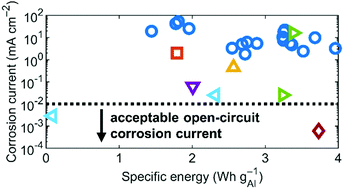
Mater. Adv., 2021,2, 1595-1599
https://doi.org/10.1039/D0MA01002B
Surface engineering of anode materials for improving sodium-ion storage performance
The surface of battery electrodes has a tremendous influence on cell performance. Recent research progress towards surface structure engineering of anode materials for sodium-ion batteries is summarized and discussed in this article.
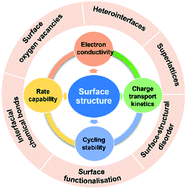
J. Mater. Chem. A, 2022,10, 3889-3904
https://doi.org/10.1039/D1TA09567F
Multivalent cationic and anionic mixed redox of an Sb2S3 cathode toward high-capacity aluminum ion batteries
A multivalent Sb-related cation (Sb(+3) ⇔ Sb(+5)) and S-related anion (S(−2) ⇔ S(0)) mixed redox Sb2S3 cathode breaks the capacity limit of conventional metal sulfides and enables high-capacity aluminum-ion batteries.
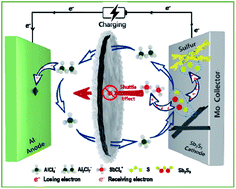
J. Mater. Chem. A, 2022,10, 10829-10836
https://doi.org/10.1039/D2TA02049A
Dual-ion charge–discharge behaviors of Na–NiNc and NiNc–NiNc batteries
Dual-ion Na–organic batteries were provided with anti-aromatic NiNc, exposing inherent charge–discharge behavior with high discharge capacity, high durability, and high Coulombic efficiency with high-density currents.
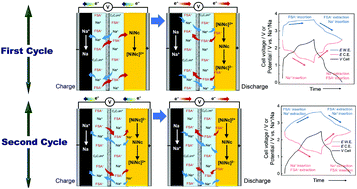
Mater. Adv., 2021,2, 2263-2266
https://doi.org/10.1039/D1MA00007A
Boron-vertex modification of carba-closo-dodecaborate for high-performance magnesium-ion battery electrolyte
A new family of Mg salts of carba-closo-dodecaborate was developed for Mg ion battery applications. Modification at the boron vertices drastically improves the solubility without compromising the chemical and redox stability.
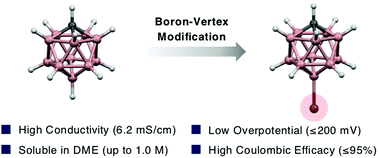
Mater. Adv., 2021,2, 937-941
https://doi.org/10.1039/D0MA00925C
Mixed ionic and electronic conducting binders containing PEDOT:PSS and organic ionic plastic crystals toward carbon-free solid-state battery cathodes
PEDOT:PSS was combined with OIPCs (C2mpyrFSI and C2mpyrTFSI) which gave high ionic and electronic conductivities and when employed for the first time in a solid-state Li|LiFePO4 cell as an OMIEC binder it showed an outstanding performance.
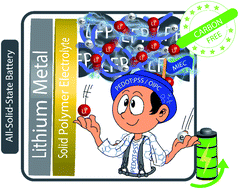
J. Mater. Chem. A, 2022,10, 19777-19786
https://doi.org/10.1039/D1TA09628A
Operando synchrotron X-ray studies of MnVOH@SWCNT nanocomposites as cathodes for high-performance aqueous zinc-ion batteries
MnVOH@SWCNTs shows a high capacity up to 381 mA h g−1 over 300 cycles. Operando XANES confirms the change in oxidation states and operando XRD shows the reversible change in the crystal structure during the cycling process.
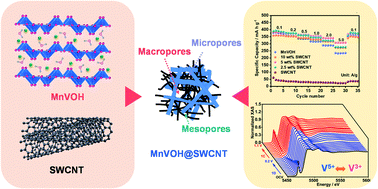
J. Mater. Chem. A, 2022,10, 14540-14554
https://doi.org/10.1039/D2TA02734H
Cellulose-assisted electrodeposition of zinc for morphological control in battery metal recycling
This study demonstrates that nanocellulose can be used in zinc electrodeposition to promote the formation of more suitable deposits for efficient metal recycling.
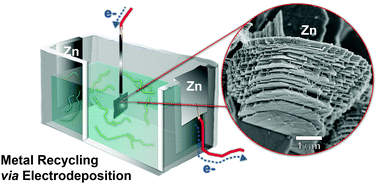
Mater. Adv., 2022,3, 5304-5314
https://doi.org/10.1039/D2MA00249C
Alloying electrode coatings towards better magnesium batteries
The surface of magnesium electrodes are protected through the action of liquid gallium. The resulting alloy coating enables enhanced plating/stripping and consequently better magnesium full cells with conventional electrolytes.
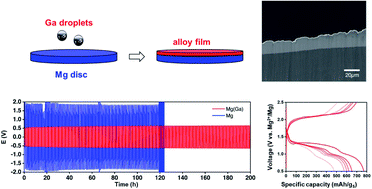
J. Mater. Chem. A, 2022,10, 12104-12113
https://doi.org/10.1039/D2TA02083A
High-performance aqueous sodium-ion/sulfur battery using elemental sulfur
A highly efficient NiVP/Pi-NCS host was constructed to realize facile polysulfide anchoring and accelerated polysulfide redox kinetics for high performance, cost-effective, and safer aqueous rechargeable Na-ion/S batteries.

J. Mater. Chem. A, 2022,10, 11394-11404
https://doi.org/10.1039/D2TA02296F
Structural alterations on the TEMPO scaffold and their impact on the performance as active materials for redox flow batteries
A comparative study was performed with five new and one known TMA-TEMPO derivatives, to elucidate the structure–stability relationship of the TEMPO scaffold and to investigate the influence on the battery performance.

Mater. Adv., 2022,3, 4278-4288
https://doi.org/10.1039/D1MA00663K
Regulating solvation and interface chemistry to inhibit corrosion of the aluminum anode in aluminum–air batteries
Introducing sodium stannate and potassium acetate in an alkaline electrolyte as a hybrid high concentration electrolyte for aluminum–air batteries.
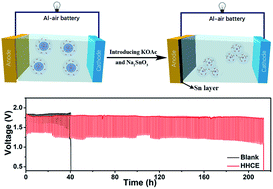
J. Mater. Chem. A, 2022,10, 9506-9514
https://doi.org/10.1039/D2TA01064J
Discovery of lead low-potential radical candidates for organic radical polymer batteries with machine-learning-assisted virtual screening
Lead candidate radicals for use in radical polymer batteries are discovered by virtual screening with low computational footprint, chemistry-informed machine learning methods.

J. Mater. Chem. A, 2022,10, 8273-8282
https://doi.org/10.1039/D2TA00743F
Ultrafast charging and ultralong cycle life in solid-state Al-ion batteries
A free-standing gel polymer electrolyte (GPE) with an ultrahigh ionic conductivity is proposed for ultrafast-charging solid-state batteries. By regulating the GPE–electrode interface, resulting Al-ion battery exhibits 17% more power/energy density.

J. Mater. Chem. A, 2022,10, 8178-8185
https://doi.org/10.1039/D2TA00630H
Using machine learning to screen non-graphite carbon materials based on Na-ion storage properties
Study of non-graphite carbon materials for sodium ion batteries. A structure–property relationship database was analyzed and applied with machine learning.
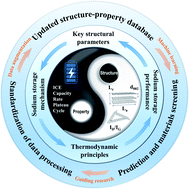
J. Mater. Chem. A, 2022,10, 8031-8046
https://doi.org/10.1039/D1TA10588D
Optimizing the Na metal/solid electrolyte interface through a grain boundary design
We propose grain boundary sealed Na3Zr2Si2PO12 (GBS-NZSP) to address the critical issues of solid-state Na batteries. Ultra-stable Na plating/striping cycles and high-rate solid-state Na metal batteries are realized at room temperature.

J. Mater. Chem. A, 2022,10, 5280-5286
https://doi.org/10.1039/D1TA10816F
Na+ diffusion mechanism and transition metal substitution in tunnel-type manganese-based oxides for Na-ion rechargeable batteries
Structural, computational and electrochemical investigations are combined to study the intercalation properties of tunnel-type Na0.44MnO2 and Cu-substituted Na0.44MnO2.
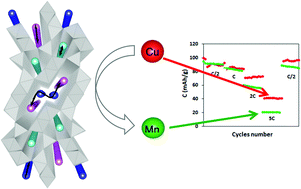
Mater. Adv., 2022,3, 986-997
https://doi.org/10.1039/D1MA00901J
Capacity and phase stability of metal-substituted α-Ni(OH)2 nanosheets in aqueous Ni–Zn batteries
Incorporating Al3+ within α-Ni(OH)2 nanosheets provides higher capacity in Ni–Zn cells with phase stability upon cycling compared to the other tested divalent substituents and unsubstituted α-Ni(OH)2.

Mater. Adv., 2021,2, 3060-3074
https://doi.org/10.1039/D1MA00080B
Biodegradable Zn-ion battery with a lignin composite electrode and bio-ionic liquid based electrolyte: possible in situ energy generation by lignin electrocatalysis
Biodegradable Zn ion batteries have been developed with lignin composite cathodes which can also generate in situ energy by lignin electrocatalytic reaction.
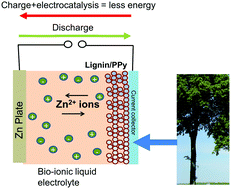
Mater. Adv., 2021,2, 2676-2683
https://doi.org/10.1039/D0MA00954G
Preparation and characterization of sodium-ion conductive Na3BS3 glass and glass–ceramic electrolytes
Glass has the highest conductivity and appropriate properties in the Na3BS3 electrolytes for all-solid-state batteries.

Mater. Adv., 2021,2, 1676-1682
https://doi.org/10.1039/D0MA00777C
Poly-anthraquinone sulfide isomers as electrode materials for extended operating temperature organic batteries
Three polyanthraquinone sulfide (PAQS) isomers were synthesized, characterized and included in a comparative study of electrochemical performances as organic material cathodes.

Mater. Adv., 2021,2, 376-383
https://doi.org/10.1039/D0MA00497A
About this collection
Current Li ion batteries are relying on critical materials that have a high risk linked to their supply, while their demand is constantly rising. Moving towards a circular battery economy is one solution, but this alone will not be able to address the issue of critical materials. The other solution is developing alternative battery chemistries based on abundant materials to complement Li-ion batteries in the future and diversify the battery market to match requirements for different applications. This collection, selected by Professor Magdalena Titirici, Imperial College London, UK, highlights some progress made in this direction based on recent papers published in Journal of Materials Chemistry A and Materials Advances.